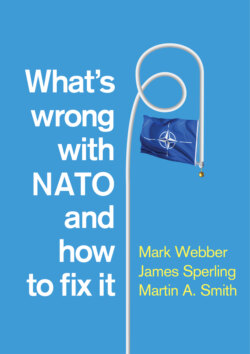Читать книгу What's Wrong with NATO and How to Fix it - Mark Webber - Страница 31
Fragmentation
ОглавлениеNATO also suffers from internal division. Alliance unity or ‘cohesion’, Patricia Weitsman has suggested, is ‘relatively easy to generate and maintain’ where there is ‘a mutual desire to contain a mutual adversary’.82 But NATO no longer has this singular focus. It has taken on more responsibilities and so there are more points of disagreement. The Alliance has also acquired more members, so making the problem worse. Just how bad things have become does need some qualifying. Weitsman points out that NATO has become an alliance that fights. Its missions in Bosnia, Kosovo, Libya and Afghanistan have all occasioned significant internal disagreement: over war aims, variable levels of commitment among the allies and the utility of force. But none of these operations has proven fatal to the Alliance. NATO’s collective resolve has held, and whatever the wisdom of the missions themselves, staying the course ‘suggests’, according to one view, ‘that the Alliance can adapt to difficult circumstances’.83
In fact, NATO suffers from a more deep-seated politicostrategic problem. As we have seen, post-Cold War threats impinge differently on the allies. NATO has responded to this problem by trying to accommodate as many viewpoints as possible. An expanded agenda, while not optimal for all allies, does at least have the benefit of ‘satisficing’, generating a minimal level of agreement on a shared interest. Further, NATO allies often have powerful secondary reasons for tacking toward security issues that do not affect them directly: a desire to be associated with the US (a factor for many allies who took part in ISAF) or for upholding solidarity as part of a broader commitment to multilateralism and transatlantic relations (one reason for Canadian involvement in NATO’s defence of the Baltic States). But while NATO has a good track record of accommodating division, the problem of fragmentation remains serious. Indeed, in 2017, NATO commissioned a project to study alliance unity, on the assumption that ‘without cohesion’, ‘NATO can and will fail’. Again, the main problem was identified as ‘differential threat assessments’,84 a problem compounded, in turn, by the erosion of liberal democratic values among some NATO allies (Hungary and Turkey most notably).85 Such divisions have had debilitating effects. Defence plans drawn up in 2016 for NATO’s eastern and southern flanks were later blocked by American and Turkish objections. This caused a big row at the 2019 NATO Leaders’ Meeting. As one analyst observed at the time, a failure to ‘retain […] cohesiveness in an environment where threats have proliferated and diversified’ might indeed ‘confirm that NATO is comatose’.86
